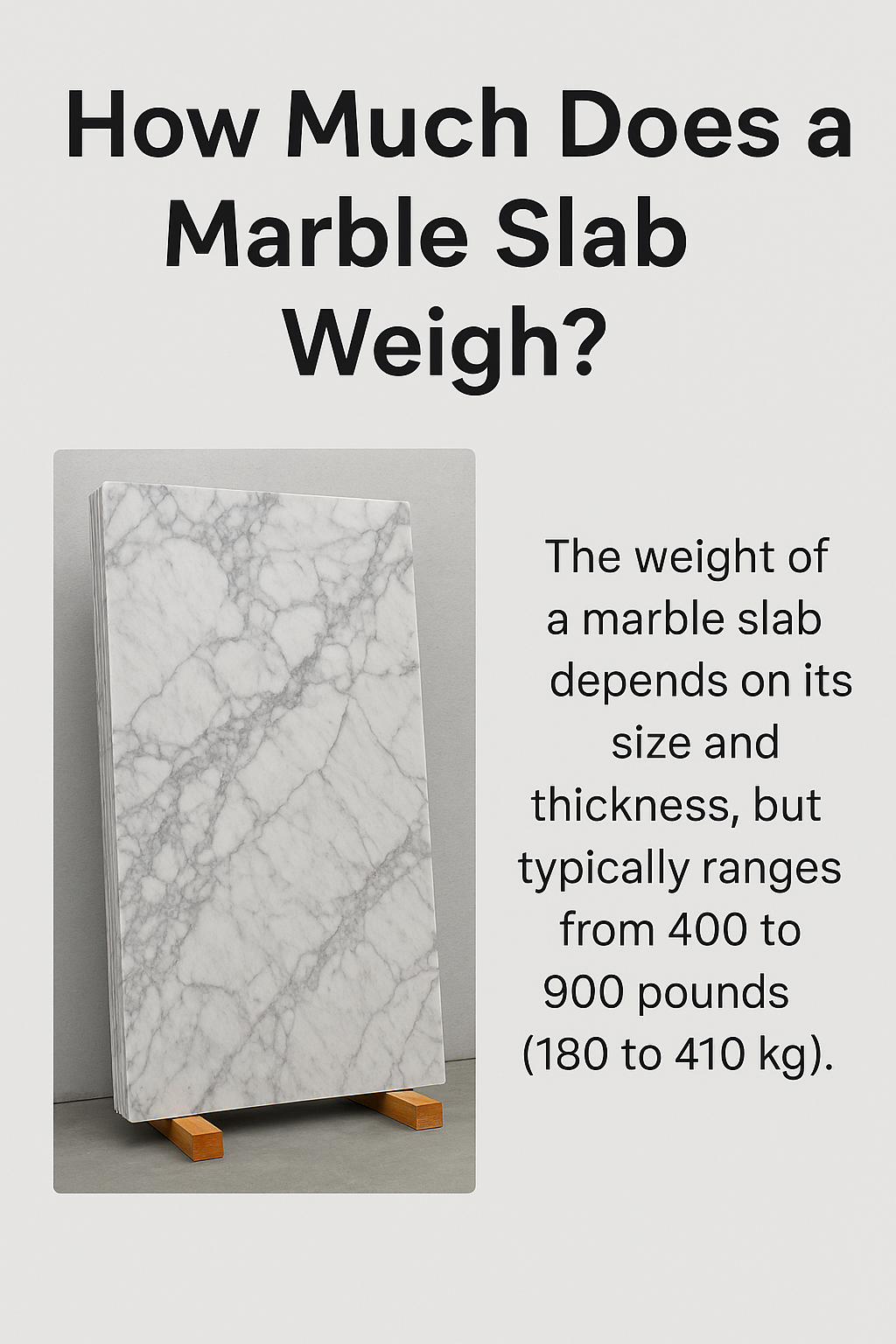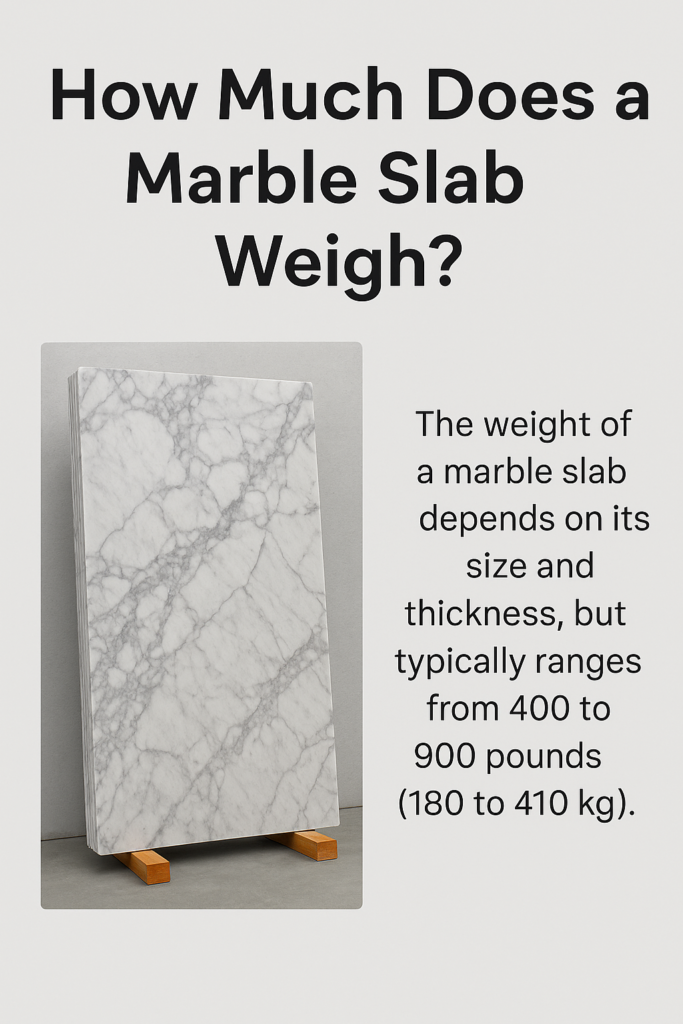
Understanding Marble Slab Weight for Smarter Construction and Design Decisions When planning a project that involves marble—whether it’s for a kitchen countertop, bathroom vanity, or wall cladding—understanding the weight of a marble slab is essential. Marble is a luxurious and durable natural material, but its density makes it significantly heavy, affecting transportation, installation, support structures,
Understanding Marble Slab Weight for Smarter Construction and Design Decisions
When planning a project that involves marble—whether it’s for a kitchen countertop, bathroom vanity, or wall cladding—understanding the weight of a marble slab is essential. Marble is a luxurious and durable natural material, but its density makes it significantly heavy, affecting transportation, installation, support structures, and even cost.
This guide will walk you through how marble slab weight is calculated, why it matters, and how it differs depending on marble slab thickness, size, and type. We’ll also compare it with granite slabs, discuss practical handling tips, and provide key insights on choosing the best marble slab for your application.

What Is a Marble Slab?
A marble slab is a thick, flat section of natural stone cut from a larger marble block. It is widely used for countertops, walls, floors, and high-end design features. Unlike tiles or engineered composites, full marble slabs offer continuous veining and minimal seams, making them ideal for luxurious, cohesive design.
Why Does Marble Slab Weight Matter?
Knowing the weight of a marble slab helps with:
- Structural planning: To ensure floors, walls, and supports can carry the load
- Transportation logistics: For packaging, lifting, and delivery
- Installation safety: Heavier slabs require professional handling
- Cost estimation: Heavier slabs may increase marble slab cost due to labor and transport fees
How to Calculate Marble Slab Weight
The weight of a marble slab depends on its dimensions and density. On average, marble has a density of 2,700 kg/m³ or 170 lbs/ft³.
Marble Slab Weight Formula:
Weight = Length × Width × Thickness × Density
Example in imperial units:
For a slab measuring 120 inches × 70 inches × 3/4 inch (20mm):
- Convert inches to feet:
Length = 10 ft, Width = 5.83 ft, Thickness = 0.0625 ft - Multiply:
10 × 5.83 × 0.0625 × 170 = 61.9 lbs
This is for 1 square foot of 3/4″ thick marble. Multiply by total area for total slab weight.
Typical Weights Based on Thickness
| Marble Slab Thickness | Weight per Square Foot | Common Use |
|---|---|---|
| 2 cm (3/4″) | ~18–20 lbs/sq ft | Countertops, backsplashes |
| 3 cm (1 1/4″) | ~27–30 lbs/sq ft | Heavy-duty counters, tables |
| Custom 4 cm+ | ~36+ lbs/sq ft | Flooring, commercial bar tops |
So a full-sized marble slab (e.g. 120″ × 70″) at 3cm thickness can weigh over 900 lbs depending on exact stone density.
Factors That Affect Marble Slab Weight
1. Marble Type
Some varieties of natural marble slabs are denser than others.
- Carrara marble slab: Lightweight with soft veining
- Calacatta marble slab: Heavier with bold veining
- Engineered marble slabs: May weigh less depending on resin content
2. Moisture Absorption
Porous stones absorb more water, slightly increasing weight if not sealed. Proper marble slab sealing can reduce this impact.
3. Finish Type
A polished marble slab may weigh slightly more than a honed marble slab due to surface compaction during finishing.
Transportation and Handling of Heavy Marble Slabs
Safe Transport Guidelines:
- Use A-frame supports during transit
- Always store slabs vertically with proper backing
- Use straps and anti-slip pads for forklifts and cranes
On-Site Handling:
- Professional marble slab installation teams use vacuum lifters or stone clamps
- Avoid laying slabs flat unless on a cushioned surface
- For flooring or wall use, ensure weight is evenly distributed
Impact on Installation and Structure
Before installing a marble slab countertop, ensure that:
- Cabinetry or framing can bear the load
- Slab seams are strategically placed to distribute weight
- Substrates are level and sealed to prevent moisture issues
Structural missteps can lead to slab cracking, especially in unsupported corners or overhangs.
Weight Comparison: Marble Slab vs Granite Slab
| Aspect | Marble Slab | Granite Slab |
|---|---|---|
| Average Density (lbs/ft³) | ~170 | ~175–180 |
| Max Size (typical) | Slightly smaller | Slightly larger |
| Brittleness | Softer, more prone to crack | Tougher and more durable |
| Ideal Use | Bathrooms, walls, backsplashes | Kitchens, exteriors, flooring |
While granite may be heavier overall, marble often requires more caution due to its fragility.
Choosing the Right Slab for Your Application
When selecting marble, balance aesthetic goals with functional needs:
- For kitchens, choose a 3cm marble slab for countertops with reinforced edges
- For bathrooms, 2cm white marble slabs or black marble slabs offer a classic contrast
- For flooring, lightweight honed slabs with anti-slip textures work best
- For wall cladding, thinner slabs reduce stress on vertical surfaces
Always consult your installer or architect about slab weight and structural limits.
Related Design and Maintenance Tips
- Match marble slab edge profiles (bullnose, ogee, square) to room style
- Pair marble slab backsplash designs with stone flooring for seamless flow
- Regular marble slab cleaning with pH-neutral cleaners extends life
- Use breathable sealers on imported marble slabs to protect veining
If damage occurs, techniques similar to granite repair can be applied to repair marble slabs.
Conclusion: Weight Matters in Marble Slab Planning
So, how much does a marble slab weigh? Depending on the size and thickness, it can range from 400 lbs to over 1,000 lbs. Knowing the weight helps you choose the right slab, plan safe installation, and avoid costly damage.
Whether you’re designing with Carrara marble slabs, Italian marble slabs, or engineered alternatives, factoring in slab weight is critical for success. Use this guide to ensure your marble project is as safe, stylish, and sustainable as it is stunning.

